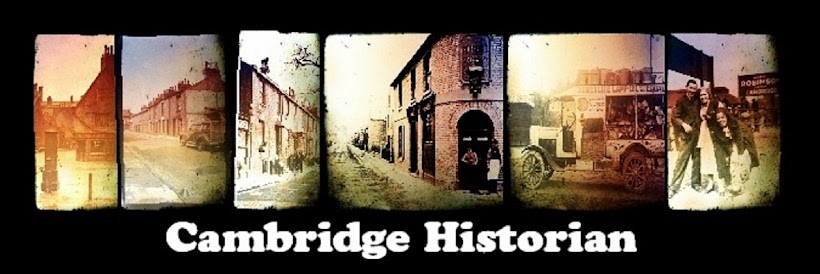 |
| Tram in Market Street - 1910s |
The first proposal for a tramway service in Cambridge came in 1878, but work did begin until 8th July 1880 under the supervision of London tramway contractor J.F. Meston. Only part of what was proposed was laid and lines along Maids Causeway, Emmanuel Road and Newmarket Road were never laid.
The cost for laying the rails was estimated at £3,617 per mile.
On Wednesday 28th October 1880, the first completed section from the railway to the post office, at the top of Petty Cury was opened. They began with six cars each drawn by a single horse. On the day of the tramways opening they were running at 30 minute intervals and carried 136 passengers, but within a few days this rose to 1,750 passengers.
The registered offices and stables were found at 184, East Road, but before they obtained these premises the horses and cars were kept in the Great Eastern Railway goods yard.
The year ending June 1887 proved to be the most successful year for the trams, travelling 89,776 miles and carrying over half a million passengers, but this good luck soon faded and the following year saw distinct reductions in profits due to poor weather causing the tramways to deteriorate.
 |
| Trams vs Buses in Regent Street - 1914 |
In 1898, a proposal came the British Electric Traction Co. LTD to purchase shares from the tramway
company in order to substitute the old horse power for electrification. The electric tramways never happened, maybe due to the complaints about the overhead wires and the negative effect it would have on shops, close to where cable supports would have to be positioned.
The tramways soon had rivals in the form of a horse drawn bus in 1896. The Cambridge Omnibus Company ran Cambridge's first bus service drawn by horses to compete with the tramways, but they needn't have worried because The Cambridge Omnibus Company went out of business in 1902.
A few years past by and the trams now got competition in the form of the motor bus. On the 15th April 1905 two companies began the first motor bus service in the city, The Cambridge University and Town Motor Omnibus Company Limited and Cambridge Motor Omnibus Company. Everyone began to think the motor bus would end the horse drawn trams, but within a a year both companies had a poor safely record and they had their licences to operate withdrawn.
In 1907 James Berry Walford brought his motor bus service to Cambridge and on the 1st August 1907 began Ortona Motor Co. The company brought three new Scott-Stirling single deckers and a second hand Maudslay double- decker, these ran in direct competition with the tramways. The new buses had the advantages that they could travel from the entrance of the rail station direct to the post office and then over the river to New Chesterton. Ortona buses also started fixed stops, while the tramways stopped whenever the passenger requested.
 |
| Final Tram 18th February 1914 |
The times seemed to be changing and the tramways manged to carry on for another seven years until receipts were so poor the company could not afford to pay the council for the upkeep of the road. A week before the closure of the tramways a notice appeared suggesting families to take their children on the trams, so they could remember them. On 18th February 1914, the last day of operation the receivers decided that the trams should stop early to prevent vandalism. The last tram left the station at 6.25pm, driven by Ephraim Skinner, the oldest and longest serving driver.









